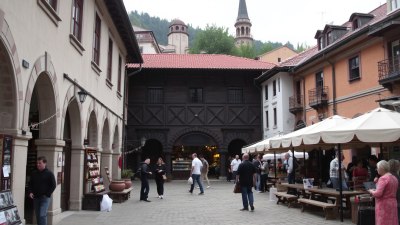How to See the Present Through the Eyes of the Past While Traveling
Discover how to connect with history during your travels for a richer experience.

Traveling is more than just visiting new places; it's about immersing oneself in different cultures, histories, and experiences. To truly understand a destination, it is essential to see the present through the eyes of the past. This approach to travel not only enriches your journey but also enhances your appreciation of the world's diverse heritage. Here are some effective strategies to help you connect with the historical backdrop of your travels.
1. Research Before You Go
Before embarking on your journey, dedicate time to research the historical context of your destination. Understanding significant events, cultural landmarks, and historical figures can enhance your travel experience. Utilize books, documentaries, and reputable online resources to gather insights. Knowing the past will help you interpret the present landscape more meaningfully.
2. Visit Museums and Historical Sites
Museums are treasure troves of history and culture, showcasing artifacts, art, and narratives that tell the story of a place. Make it a priority to visit local museums and historical sites. These locations often house exhibitions that provide context to the present and illustrate the evolution of the area. Look for guided tours, as knowledgeable guides can share fascinating stories and lesser-known facts that enrich your understanding.
3. Engage with Local Histories
Every locale has its own unique history shaped by various influences. Engaging with locals can provide personal narratives that complement the formal history. Visit local cafes, markets, or events and strike up conversations with residents. Ask questions about their experiences, traditions, and historical anecdotes. You might discover stories that aren’t found in guidebooks, adding depth to your travel experience.
4. Explore Historical Architecture
Architecture serves as a physical manifestation of history. It reflects cultural influences, technological advancements, and artistic trends over time. As you explore new destinations, take note of the architectural styles. Visit historical neighborhoods and buildings, ranging from ancient ruins to colonial structures. Each piece of architecture has a story to tell, providing a window into the past while framing the present.
5. Participate in Traditional Activities
Engaging in traditional practices or festivals allows travelers to experience a culture in its most authentic form. Whether it’s participating in a cooking class, watching a cultural performance, or taking part in a local celebration, these activities offer a glimpse into the customs that have shaped a community over generations. Learning about the significance of these traditions can help unify past and present experiences.
6. Take Historical Tours
Many cities offer historical walking tours led by knowledgeable guides who can provide insight into the area's past. These tours can be thematic, focusing on aspects like architecture, social movements, or famous figures. Make sure to choose a tour that aligns with your interests, as it will enable you to learn while enjoying the walk. The experience can be both educational and enjoyable, helping you visualize past events in the current context.
7. Connect with Literature and Art
Literature and art often reflect the social and political landscapes of their time, serving as a lens through which to understand the past. Before traveling, consider reading novels, poetry, or historical accounts related to your destination. Once there, visit galleries and theaters to explore how local artists interpret their environment. This artistic connection can give you a richer understanding of how history influences contemporary culture.
8. Reflect in Nature
Nature can also tell a story, providing insights into the historical significance of a location. Explore natural landmarks, such as parks or archaeological sites, where the interplay between nature and human activity unfolds. Consider how the environment has influenced local culture and history. For instance, rivers often played a crucial role in trade and settlement, while mountains can evoke legends and tales from different eras.
9. Document Your Journey
As you travel, take notes or keep a travel journal. Write about your experiences, thoughts, and feelings regarding how the past influences the present. Not only does this practice help in processing what you’ve learned, but it also creates a personal historical record of your journey. Reflecting on your musings can lead to deeper insights and connections long after your travels have ended.
10. Use Technology to Your Advantage
In the modern age, technology plays a crucial role in the way we interact with the past. Utilize apps and online resources that allow you to explore historical data and narratives. Virtual reality experiences can immerse you in significant historical sites, enhancing your understanding of their importance. Likewise, augmented reality applications can provide on-the-spot historical information as you explore, enriching your experience.
11. Attend Local Lectures and Workshops
Many cities offer lectures, workshops, and talks given by historians, authors, or local experts. These events often delve into specific historical topics or cultural practices, offering an opportunity for deeper learning. Attending such gatherings can connect you with other history enthusiasts and expand your understanding of the significance of the area you are visiting.
12. Foster a Respectful Mindset
When exploring historical sites, it is vital to adopt a respectful mindset. Acknowledge the narratives, struggles, and triumphs that have shaped the place. Be mindful of cultural sensitivities, especially in sites with historical pain or conflict. A respectful attitude can lead to a more meaningful experience, allowing you to appreciate the complexities of a location’s past.
13. Return to the Present with New Perspectives
Ultimately, the goal of viewing the present through the eyes of the past is to return home with newfound perspectives. Reflect on how your travels have shifted your understanding of global cultures, histories, and relationships. Consider how your experiences can influence your actions and thoughts moving forward. The past is not just a series of events; it is a tapestry that weaves into the fabric of our current world.
14. Embrace Authenticity in Your Journey
Participating in authentic experiences leads to a deeper connection with the history and culture of your destination. Seek out locally-owned businesses, artisans, and cultural exchanges. Supporting authentic experiences enriches your journey and gives you insights into sustainable practices rooted in historical traditions. By doing so, you're not just a traveler but also a participant in the living history of the place.
15. Create a Personal Connection to History
As you connect with the stories of a place, aim to create your personal narrative. Identify aspects of the history that resonate with you, whether it’s a story of resilience, innovation, or struggle. Frame your travels as an opportunity to explore your interests and passions in relation to history. This connection can render your travels even more meaningful and memorable, contributing to your ongoing growth.
Traveling with an awareness of history allows you to see beyond the surface of a place, deepening your understanding of its current identity and cultural significance. By connecting past and present through research, local engagement, immersive experiences, and reflection, you create a richer travel narrative that continues to evolve long after your journey ends. Embrace history as an integral part of your travel experiences, allowing it to shape your perspective and appreciation of the world.











